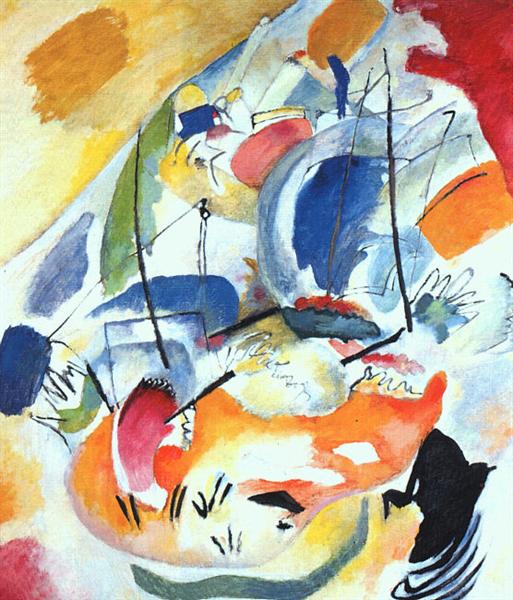Description
The work "Improvisation 31 (Naval Battle)" by Wassily Kandinsky, painted in 1913, is a paradigmatic example of the artist's search to transcend the representational and achieve a purely abstract language that allowed the expression of emotions and moods through the color and shape. Kandinsky, one of the pioneers of abstract art, enters an explosive visual narrative that evokes the intensity of a naval combat, although in a non -literal sense. The painting is characterized by a dynamic composition, where shapes and colors merge into a chaotic dance that suggests the ferocity and violence of the battle.
The use of color in this work is fundamental and reflects Kandinsky's theory about the relationship between color and emotion. Blue tones predominate, which evoke water and sky, and are contrasted with darker nuances that could be interpreted as the shadow of war. The brushstrokes are intense and gestural, creating a sense of movement and agitation. From the upper edge of the paint, a series of curves and lines are crossed by red color explosions and darker sepias, possibly representing ships or destroyed structures. Kandinsky moves away from the figurative representation and focuses on the emotional experience that the work generates in the viewer.
In terms of composition, "Improvisation 31" presents a structure that could be described as a visual symphony. The abstract shapes, which emerge between the colored whirlwind, seem to dialogue with each other, creating a sense of depth and conflict. Although there are no discernible characters that can be identified, the feeling of human presence is palpable, since the dynamics between forms can be interpreted as an allusion to human emotions experienced during the war: anxiety, chaos and the struggle for survival .
The work is within the context of abstract expressionism, movement with which Kandinsky was intimately linked and sought to exterior subjectivity and internal in a visual way. "Improvisation 31" is aligned with other works of the same period, where the theme of war and its emotional impact became relevant. This type of "improvisations" are characterized by freedom of expression and the exploration of new possibilities in art, breaking the established norms of the past.
Kandinsky composed this work in a period of great agitation in Europe, just before the outbreak of World War I, adding a layer of deep meaning to the work. The feeling of chaos and conflict could be interpreted as an anticipation of the events that were to come, and in this sense, "Improvisation 31" is not only an aesthetic exploration, but also a comment on the human condition in times of crisis.
In sum, "Improvisation 31 (Naval Battle)" is erected as a powerful testimony of Kandinsky's ability to cover complex emotions through the use of color, shape and abstraction. The work invites the spectator to immerse himself in an ocean of sensations, where the battle, in its broadest sense, is lived not through the tangible, but through the purely spiritual and emotional. This piece attests to the ability of art to capture the tumultuous essence of human life, making this work not only a milestone in Kandinsky's trajectory, but also a lighthouse of the evolution of modern art.
KUADROS ©, a famous paint on your wall.
Hand-made oil painting reproductions, with the quality of professional artists and the distinctive seal of KUADROS ©.
Art reproduction service with satisfaction guarantee. If you are not completely satisfied with the replica of your painting, we refund your money 100%.

